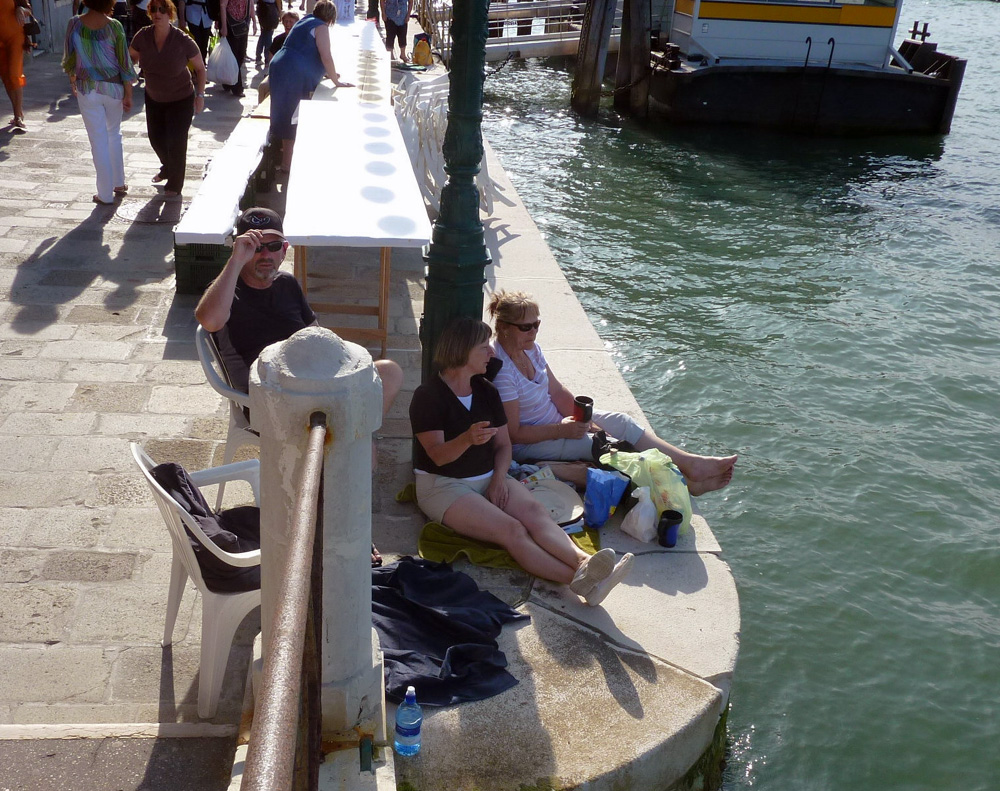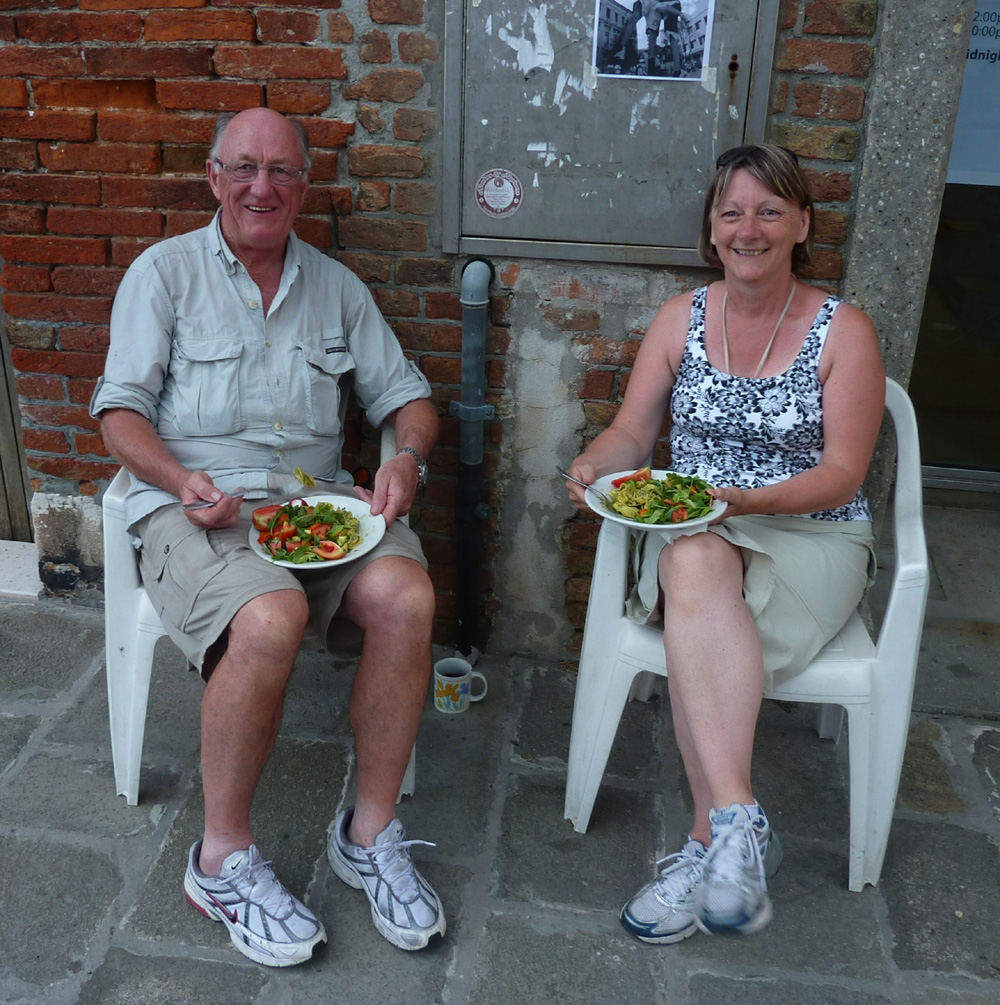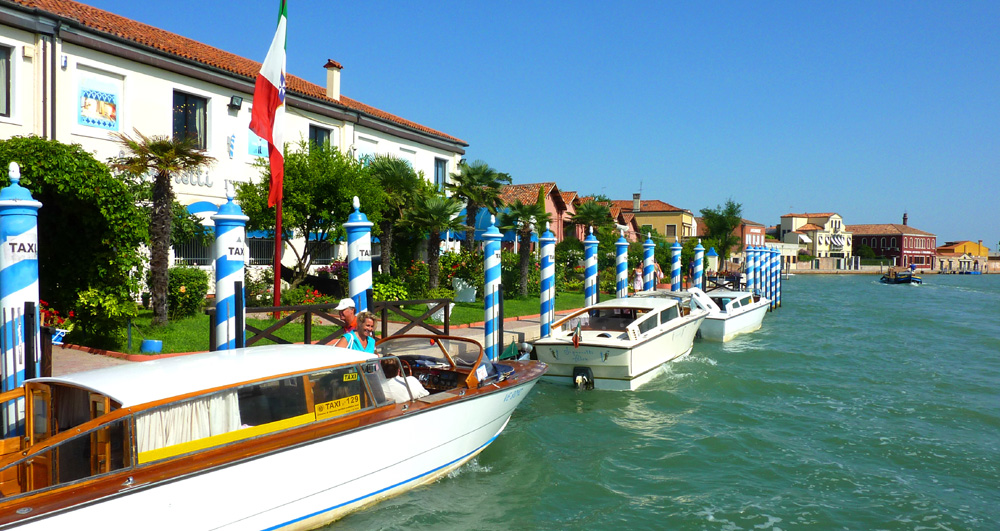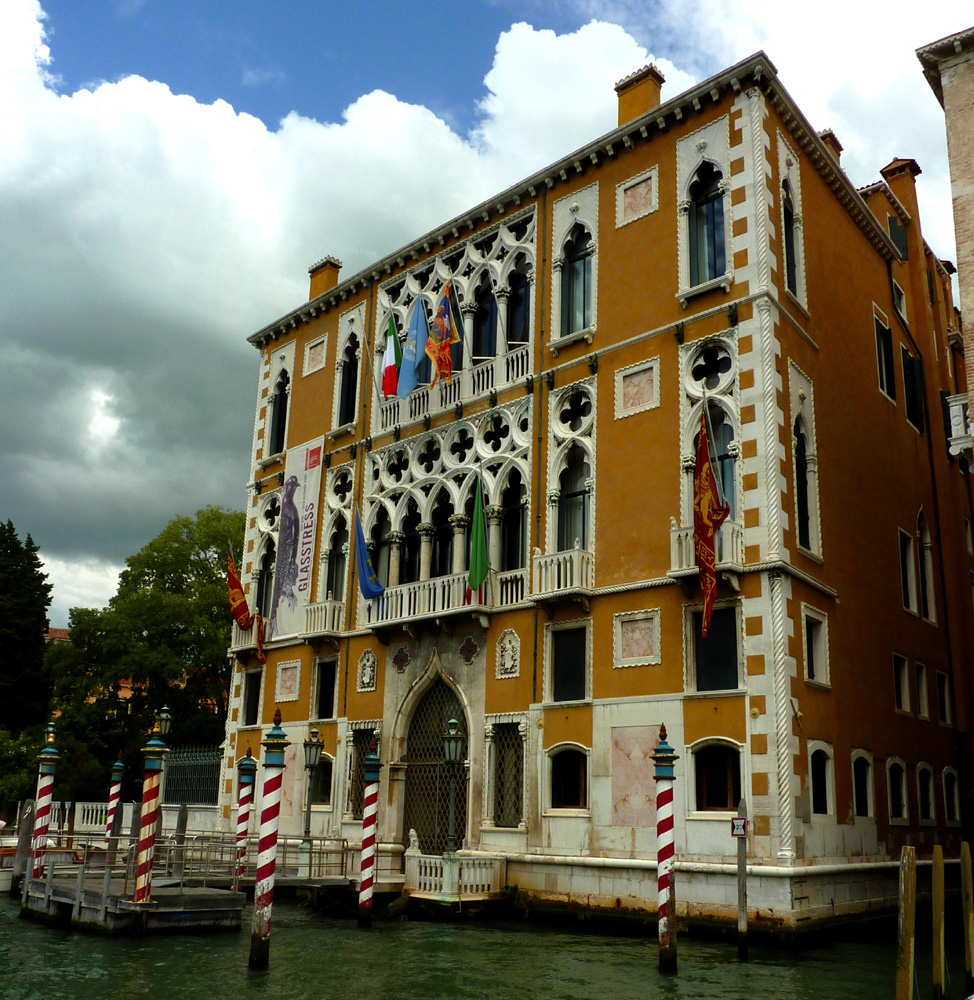Venice: The City of Water (1/4)
The above canal scene was taken while on the deck of one of the hundreds of ACTV Ferries that ply the city waterways.
Note: The following four-part Travelogue is from a tour Lynn and I made in 2009. It was first posted live to Facebook and is being reposted here along with more photographs taken during the trip.
Meeting New Friends
As luck would have it, our seven-hour train ride from Interlaken, Switzerland, to Venice (Venezia), the historic capital of the Venetian Republic, seemed much shorter after having  met two delightful young ladies from Australia. These chitty, chatty young women reminded us so much of Vicki, our homestay student from the early 1990’s. As with Vicki, these two girls were experienced travelers who, having visited Venice before, provided the ‘old folks’ with several tips.
met two delightful young ladies from Australia. These chitty, chatty young women reminded us so much of Vicki, our homestay student from the early 1990’s. As with Vicki, these two girls were experienced travelers who, having visited Venice before, provided the ‘old folks’ with several tips.
 As for the best place to stay, they suggested searching out a hostel on Giudecca Island, a short ferry ride from Piazza San Marco Square, the main public square in Venice. Also, to make our touring easier, they suggested the purchase of a one, three or five-day ferry pass. The unlimited ‘on and off’ privileges would provide access to every nook and cranny of this city, unique in that access to every street and alley is provided by the canal in the same manner paved streets provide that access in every other city in the world. A second honeymoon Lynn, here we come.
As for the best place to stay, they suggested searching out a hostel on Giudecca Island, a short ferry ride from Piazza San Marco Square, the main public square in Venice. Also, to make our touring easier, they suggested the purchase of a one, three or five-day ferry pass. The unlimited ‘on and off’ privileges would provide access to every nook and cranny of this city, unique in that access to every street and alley is provided by the canal in the same manner paved streets provide that access in every other city in the world. A second honeymoon Lynn, here we come.
Venice, “the most beautiful and romantic city built by man.”
We arrived late in the afternoon when the city was packed to the gunnels (see the ferry picture below) as it hosted the Venice Biennale Contemporary Art Exhibition, an event held every second year since 1895. In addition to this incredible Art Exhibition, Venice was preparing to celebrate the end of a 1575 outbreak of the Bubonic Plague that lasted two years and killed an estimated 50,000 people (about 30% of the city population). Coincidently, the plague ended just as a church, the Chiesa del Santissimo Redentore (SS Rendentore) was completed, a short distance across the Canale della Giudecca, on Giudecca Island.
Completion of the church was soon given as the reason the plague had suddenly ended and every year since the 1600s, the Festa del Redentore is celebrated on the third week-end of July. The Festa will attract more than 250,000 people to the city centre over the week-end. To accommodate the many celebrants who wish to visit the church, a floating bridge was to be built across the 500-metre canal from the Piazza to the very steps of the SS Redentore. That should prove interesting, as the canal is a waterway through which massive cruise ships and hundreds of other watercraft regularly travel.
 Lynn and I decided to follow the advice of our new friends and headed for the Island. After a short ferry ride, we chanced upon excellent lodging (with full kitchen) at a University Hostel right on the canal, immediately across from the Piazza and almost next door to the SS Redentore. The reason for our good luck was that a number of students had just finished classes and were heading away for holidays or summer work.
Lynn and I decided to follow the advice of our new friends and headed for the Island. After a short ferry ride, we chanced upon excellent lodging (with full kitchen) at a University Hostel right on the canal, immediately across from the Piazza and almost next door to the SS Redentore. The reason for our good luck was that a number of students had just finished classes and were heading away for holidays or summer work.
Once registered, we soon made friends with other guests, including a young couple from Montreal on one of their annual treks around the world, and a young lady from Palo Alto, California, who was taking a holiday from a two-year teaching assignment with Teachers of America, in Phoenix, Arizona.
 After a glass (or two, or three) of wine, and conversation about homes, families, lives, travel, and politics of the world, we said goodnight in anticipation of exploring this amazing 1000-year-old city – home to 275,000 – a bit smaller than our home city of Victoria, British Columbia.
After a glass (or two, or three) of wine, and conversation about homes, families, lives, travel, and politics of the world, we said goodnight in anticipation of exploring this amazing 1000-year-old city – home to 275,000 – a bit smaller than our home city of Victoria, British Columbia.
Venice, the most accessible city in Europe
After a solid sleep, we were out bright and early, purchased a five-day pass and began exploring. Our exploration begins in photo story attached to this post. (That small Panasonic digital camera I purchased just before our travels to Europe, has worked wonders, as it seems that every place we travel is filled with a never-ending array of scenes that beg to be recorded.)
 At every turn during our explorations, we found the people most welcoming. Seldom did we travel far before being waylaid in conversation over a coffee, tea or glass of wine – A lady with a strong Bronx accent who came to Venice thirty years before, fell in love with the city and never left; a dad on a walk-a-bout with his daughter; an old fisherman just back with his catch, and dozens of others in kiosks and shops along the way.
At every turn during our explorations, we found the people most welcoming. Seldom did we travel far before being waylaid in conversation over a coffee, tea or glass of wine – A lady with a strong Bronx accent who came to Venice thirty years before, fell in love with the city and never left; a dad on a walk-a-bout with his daughter; an old fisherman just back with his catch, and dozens of others in kiosks and shops along the way.
That ‘on and off’ ferry pass and the hundreds of sidewalk stops provided exceptional access to every part of the city. The ferry system is definitely one of the key factors in making Venice such an accessible city for tourists. Even if not able to walk far, during the less busy times, you could spend hours relaxing on the ferry and taking in the scenery around the dozens of small Islands that make up the city core.
On Friday afternoon, after two full days of exploring, we noticed heavy storm clouds building in the west, so decided to beat a hasty retreat to Giudecca Island before the storm broke. Having become familiar with the regular, but occasionally heavily loaded ferries, we preferred to hole up ‘at home’ with a glass of wine and a plate of pasta rather than having to wait out the storm in one of the ferry kiosks.
 As with most transit systems, the peak hours and the Friday afternoon rush in Venice is madness. Obviously, there were no rules about capacity, if you could hang on to a rail as the ferry left, you were a passenger. For a Canadian, whose water transport rules and regulations require a life jacket and training drills before taking a bath, it was disconcerting to ride on a ferry that often had only 3” of freeboard and the nearest lifejacket somewhere in a museum.
As with most transit systems, the peak hours and the Friday afternoon rush in Venice is madness. Obviously, there were no rules about capacity, if you could hang on to a rail as the ferry left, you were a passenger. For a Canadian, whose water transport rules and regulations require a life jacket and training drills before taking a bath, it was disconcerting to ride on a ferry that often had only 3” of freeboard and the nearest lifejacket somewhere in a museum.
Photo: Friday afternoon rush hour. Can imagine this ferry with another thirty or forty people on board and a storm brewing. It would be far better to be on shore sipping wine.
The moment we stepped off the ferry the storm broke with thunder, lightning, heavy rain, hail and strong winds that equaled the best of the best we had experienced in Canada. As the winds rose the ferries stopped running and, as expected, many people were caught and had to seek shelter in the kiosks, one of which was immediately outside our hostel. The storm was actually a welcome event as it knocked the temperature down several from the mid-thirties we had experienced over the past few days. When it broke we headed out for a walk along the canal.
Meeting Old Friends
Not five minutes into our walk we ran into the couple from New Zealand with whom we had shared such a wonderful adventure traveling to the top of Europe in the Swiss Alps. Karen and Knobby Clarke had not planned to travel to Venice, but at the last minute had changed plans. They were now staying in a hostel no more than a half-block from our own. This unexpected meeting with the Clarke’s was just one more of the dozens of ‘small world’ events we have experienced over the past few years of traveling. That evening, with our ‘old’ and ‘new’ friends, gathered over wine and pasta, it was clear our holiday in Venice was going to be another memorable adventure.
 That evening the seven of us decided to stake out some territory on the canal for the week-end SS Redentore celebrations and to buy up enough food and wine to carry us over a few meals. We expected the sidewalks would be packed but noticed a few tables being set up to mark off territory. We selected a little nook below a bridge that would serve our purpose very well.
That evening the seven of us decided to stake out some territory on the canal for the week-end SS Redentore celebrations and to buy up enough food and wine to carry us over a few meals. We expected the sidewalks would be packed but noticed a few tables being set up to mark off territory. We selected a little nook below a bridge that would serve our purpose very well.
Photo: Lynn, Karen and Knobby stake out waterfront property. In the background, a table is set for a family. Further in the background the ferry stop in front of our hostel.
Another thing you will note about Venice is a lack of guardrails. I suppose the thinking is that as water is a way of life in Venice if you are as careless or stupid as to end up in one of the canals, you deserve to get wet. In Canada, we often build our guardrails so high you cannot see the water. As we say in Canada, ‘better to be safe than sorry’. For hardy peoples of the “Great White North’ we certainly have some really wimpy rules and regulations.
For meals the next day, Lynn and I had full access that great kitchen in the hostel that was less than twenty feet from the area we had staked as ‘our’ territory. Once settled in we were among the chosen few. As the day progressed more people set up tables, some fully set with linen, china, and candles for families of 10 or 20, right on the water. There was no such thing as a permit for liquor and I do not recall ever seeing a policeman in the crowd. The only police we observed were in watercraft (their police cars) and whose main job was to keep boaters from blocking access to the various channels that connected to the main canal.
linen, china, and candles for families of 10 or 20, right on the water. There was no such thing as a permit for liquor and I do not recall ever seeing a policeman in the crowd. The only police we observed were in watercraft (their police cars) and whose main job was to keep boaters from blocking access to the various channels that connected to the main canal.
It seemed the policemen in Venice were not very much different from others around the world, as at one point they just ‘happened’ to find two young women in distress who needed a lift back across the canal. Obviously, as it was an ‘emergency’, they were glad to help. They returned after a half hour happily chatting away, likely with a contact number in their notebook.
At another point, when asking some young men and their girlfriends to back their boat from blocking a side channel entrance, the young men explained they were just waiting for other friends to arrive with the beer (I don’t speak Italian but I eventually figured out the story). The two policemen gave them time and even helped to steady their boat as the men loaded three or four cases of beer and a couple more girls into their boat. Do you think that would happen in Canada? Only in your dreams!
Over the day the number of boats on the canal grew from 10 to a 100 to 1000 with many so overloaded, it was amazing they continued to float. Again, never did we see a life jacket. One day when back home, I shall sit down and check the statistics of drowning deaths in Venice versus those in Canada. I bet it will be much lower in Venice.
The pictures and stories of our day on the canal watching the festivities, as well as our final two days visiting the many venues of the Contemporary Art’s Festival, will be included in the next two posts.
Links to
Venice: Festa del Redentore (2/4)
Venice: Biennial Contemporary Arts Exhibition (3/4)
Venice: Travel Planning (4/4)
Canal and City Scenes

View of the Piazza Saint Marco was taken from church tower near our Hostel.
The built-up city area you see behind the Piazza is filled with dozens of waterways

This main waterway winds back from the Giudecca Canale. Smaller waterways, some no larger than the width of
a boat, serve as side streets and alleys. While taking a ferry or water taxi is one way to view the city, it is also
possible to walk for miles using small bridges over the various canals. One larger bridge is show in the cover photo on this post.

A Gondola ride through the waters of Venice is must for most tourists

Taxi Stands around the City, provide fast, easy and comfortable service although
it is more expensive than a multi-day ferry pass.

Submarine Restaurant serving the original ‘submarine sandwich’ in Venice. By the looks
of the Star on the conning tower, this submarine must have arrived via Russia.

A man prepares his Gondola for another day of service

A typical refurbished building. As you will note in these photos, the brightly painted buildings of Venice
add greatly to the ambience of he city. I assume the building below is a embassy of some sort.

This building, near the main ferry terminal on Giudecca Canale, is currently under renovation. It is evident
that rising sea levels would have a huge impact upon the city.

The typical ferry interior is very comfortable although during busy periods, extremely crowded.
Exterior seats and standing area is available.













(800)
Tags: Harold McNeill, Italy, Knobby Clarke, Lynn McNeill, Venice
Trackback from your site.
